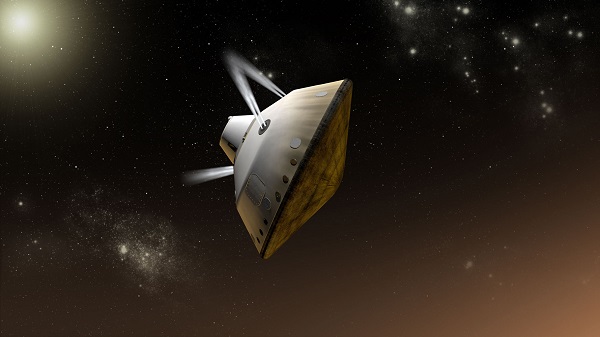
One of the (many) challenges of landing a spacecraft on Mars is getting it to settle on the surface safely, without impacting too hard or damaging any of the delicate scientific equipment on board. The heavier the craft, the more difficult a safe landing is to achieve, which is why the heaviest vehicle landed on Mars so far is the Curiosity Rover which weighs a relatively light 1 metric ton (2,200 lbs). In the future, for projects like Mars 2020 and beyond, scientists will want to land heavier payloads of 5 to 20 tons to allow for more equipment and larger instruments, and a new paper has suggestions for how these heavier loads could be landed.
The traditional solution to the problem of landing a spacecraft is to use a parachute to slow down its decent until it can touch down safely. In addition to the parachute, rocket engines or air bags can be used in the final portion of the landing to act as a cushion and lessen the force of impact. But this doesn’t work for heavier craft: “Unfortunately, parachute systems do not scale well with increasing vehicle mass,” Zach Putnam, assistant professor in the Department of Aerospace Engineering at the University of Illinois at Urbana-Champaign and author of the paper, said in a statement. “The new idea is to eliminate the parachute and use larger rocket engines for descent.”
Putnam and his colleague Christopher Lorenz propose using retropropulsion engines which fire in the opposite direction to the movement of the craft in order to slow it down. The issue with this approach is that it uses a huge amount of fuel which adds to the mass of the craft. But the researchers found that they could mitigate this effect by moving the center of gravity of the craft so that it is heavier on one side and flies at an angle. This happens because an offset means that the atmosphere flows differently over the top and bottom of the craft, creating a pressure differential which can be used to maneuver the craft during deceleration.
“We have a certain amount of control authority during entry, descent, and landing — that is, the ability to steer,” Putnam said. “To maximize the amount of mass we can landing on the surface, the altitude at which you ignite your descent engines is important, but also the angle your velocity vector makes with the horizon—how steep you’re coming in.”
The study is published in the Journal of Spacecraft and Rockets.
Editors' Recommendations
- Could there be underground lakes on Mars’s southern pole?
- China successfully lands a rover on Mars for the first time
- NASA just released this awe-inspiring video of Perseverance’s landing on Mars
- NASA to release actual footage of Mars rover landing. Here’s how to watch
- When will NASA’s Ingenuity helicopter take its first flight on Mars?




